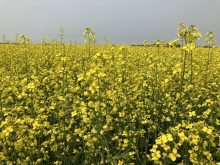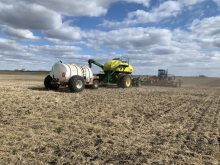North Dakota has a bumper crop of spring wheat on the way, according to the co-ordinator of an extensive three-day tour of the state’s wheat fields.
“It looks like a pretty late-planted crop that has really got great potential,” said Dave Green, executive vice-president of the Wheat Quality Council.
The group is forecasting a record yield of 49.1 bushels per acre, which is slightly below the United States Department of Agriculture’s July 1 forecast of 51 bu. per acre for the state.
Read Also

New coal mine proposal met with old concerns
A smaller version of the previously rejected Grassy Mountain coal mine project in Crowsnest Pass is back on the table, and the Livingstone Landowners Group continues to voice concerns about the environmental risks.
The council’s forecast is based on a survey of 267 spring wheat fields conducted July 26-28.
Green said there were fields that were still six weeks out in northern North Dakota, which means they will likely be harvested in the first week of September. That is worrisome.
“You’d rather have it off in the middle of August than that late, but that’s what they’re stuck with,” he said.
“Everybody is just hoping for a late fall.”
There were no major disease or insect issues with the crop. Pest damage will be minor compared to normal.
But there is one lingering concern with the spring wheat crop aside from the lateness.
“It looks like a big crop, which gets people worried about protein but that could be solved with a week of 95-degree (Fahrenheit) weather,” he said.
MarketsFarm analyst Bruce Burnett thinks the spring wheat estimate is optimistic. The North Dakota crop tour numbers tend to be robust in years like this when the crop is late developing.
He thinks there could be more disease damage than they are anticipating.
Manitoba has had similar growing conditions and Manitoba Agriculture is reporting elevated risk for many fungal diseases and moderate to extreme fusarium head blight risk for much of the province.
But he agrees that North Dakota is on its way to having a good rebound year.
“There’s no denying it’s going to be a decent-sized crop this year,” said Burnett.
He cautioned people against drawing the conclusion that the Canadian Prairies are heading for record yields as well.
While Manitoba and eastern Saskatchewan have had similar growing conditions as North Dakota that is not the case in the rest of the Prairies.
Conditions in southwest and west-central Saskatchewan are decidedly different.
“They are diametrically opposed to what the conditions outlined in the crop tour were in North Dakota,” said Burnett.
He thinks that overall spring wheat yields in Western Canada will be closer to average than record levels. And there is a big risk of frost damage in the eastern Prairies, which could affect yields and quality.
Green said the durum yield forecast for North Dakota came in at 39 bu. per acre, slightly below the USDA’s July 1 estimate of 40.
That is a “middle-of-the-road” yield for the state but that could be due to the small sample size of 35 fields.
“We don’t get to as many fields as we should to forecast the crop,” he said.
“I suspect the crop may be better, but we just didn’t stop at enough durum fields.”
Green estimates that 90 percent of the traditional wheat and durum fields in southeast North Dakota have been lost to corn and soybeans.
The state is on such a wet weather cycle that durum production has shifted to Montana.
Burnett said the crop ratings for durum in North Dakota have been good, so maybe Green is right that the final yield could be higher.
sean.pratt@producer.com

















